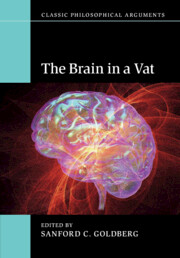Book contents
- Frontmatter
- Contents
- List of contributors
- Acknowledgments
- 1 Introduction: Putnam's reflections on the brain in a vat
- Part I Intentionality and the philosophy of mind and language
- Part II Epistemology
- Part III Metaphysics
- 9 Brains in vats and model theory
- 10 Realism, skepticism, and the brain in a vat
- 11 Rethinking semantic naturalism
- 12 Internal to what? Contemporary naturalism and Putnam's model-theoretic argument
- 13 The model-theoretic argument: from skepticism to a new understanding
- 14 Eligibility and ideology in the vat
- Bibliography
- Index
12 - Internal to what? Contemporary naturalism and Putnam's model-theoretic argument
from Part III - Metaphysics
Published online by Cambridge University Press: 05 June 2016
- Frontmatter
- Contents
- List of contributors
- Acknowledgments
- 1 Introduction: Putnam's reflections on the brain in a vat
- Part I Intentionality and the philosophy of mind and language
- Part II Epistemology
- Part III Metaphysics
- 9 Brains in vats and model theory
- 10 Realism, skepticism, and the brain in a vat
- 11 Rethinking semantic naturalism
- 12 Internal to what? Contemporary naturalism and Putnam's model-theoretic argument
- 13 The model-theoretic argument: from skepticism to a new understanding
- 14 Eligibility and ideology in the vat
- Bibliography
- Index
Summary
In Reason, Truth, and History (Putnam 1981a), Hilary Putnam deploys the model-theoretic argument (MTA) against metaphysical realism, arguing for an “internalist” alternative and applying his thoughts to a wide range of philosophical problems. This chapter examines some of Putnam's ideas from the point of view of contemporary naturalism. Naturalism shares with internalism some central elements, such as rejection of a God's eye point of view, yet there are deep methodological differences. Here, I discuss some of these differences through consideration of various matters such as theories of reference and truth, the existence of mathematical objects, and brain-in-a-vat type skepticism. I argue that, though the internalist and naturalist share an interest in “our” methods, one point of divergence is over what this comes to, with particular disagreement over the question of whether the methods we associate with science have special epistemic status. Toward the end I explore some practical implications of this difference.
Internalism and naturalism
In a (1993) paper, Putnam expresses his pleasure that “most” of the readers of Reason, Truth, and History have correctly interpreted its argument as a reductio. The position being reduced to absurdity is, of course, metaphysical realism. On the metaphysical realist perspective, “the world consists of some fixed totality of mind-independent objects. There is exactly one true and complete description of ‘the way the world is.’ Truth involves some sort of correspondence between words or thought-signs and external things and sets of things” (Putnam 1981a: 49). Putnam dubs this perspective “the externalist perspective,” because “its favorite point of view is a God's Eye point of view” (49).
One of Putnam's strategies for reducing metaphysical realism to absurdity is through the model-theoretic argument. That argument assumes that there is a reference relation R attaching words to things, and draws the conclusion that, even while keeping the truth values of all of our sentences fixed, there are infinitely many relations that R could be. From this, Putnam says, it follows that “there are always infinitely many different interpretations of the predicates of a language which assign the ‘correct’ truth-values to the sentences in all possible worlds, no matter how those ‘correct’ truth-values are singled out” – a conclusion, he suggests, that we cannot accept (Putnam 1981a: 35).
- Type
- Chapter
- Information
- The Brain in a Vat , pp. 190 - 207Publisher: Cambridge University PressPrint publication year: 2016



